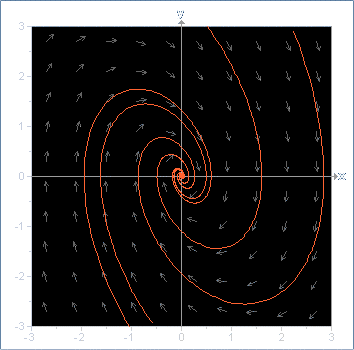 Second Order Equations and Systems
Second Order Equations and Systems  Second Order Equations and Systems
Second Order Equations and Systems

We have seen before how to solve some type of second order equations. In fact, we have only seen how to solve linear equations. So what happened to nonlinear equations ? Unfortunately many of real life problems are modelled by nonlinear equations. Here we will show how a second order equation may rewritten as a system. The technique developed for the system may then be used to study second order equation even if they are not linear.
Any second order differential equation is given (in the explicit form) as
![]()
Let us introduce the function
![]()
Then we have
![]()
Putting everything together we get

It is very easy to see that y(t) is solution to the second order
equation if and only if (y,v) is solution to the system. Keep in
mind, that our original problem deals with y(t). Therefore, the
phase plane of the system is not as important as if we were only
dealing with the associated system. This is another reason why we
should also pay attention to the graph of y versus t.
Harmonic Oscillator
The mass-spring apparatus is called the Harmonic oscillator and
is one of the most important models in science (specially in physics).
This model also rises in circuit theory (RLC circuits) and in physics
of particles.
A very rough description of the mass-spring apparatus is:
![]()
in the absence of an external force acting on the object. Recall that y(t) denotes the position of the object at time t. We are clearly assuming that the motion is linear (that is along a line). Before we write down the associated system, we rewrite the equation in the explicit form
![]()
The associated system is

Undamped Harmonic Oscillators
These are harmonic oscillators for which ![]() . In this case, the
differential equation reduces to
. In this case, the
differential equation reduces to
![]()
or equivalently
![]()
or
![]()
The associated system is

Example. Consider the harmonic oscillators
| 1. | 
|
| 2. | 
|
| 3. | 
|

 S.O.S MATHematics home page
S.O.S MATHematics home page .
